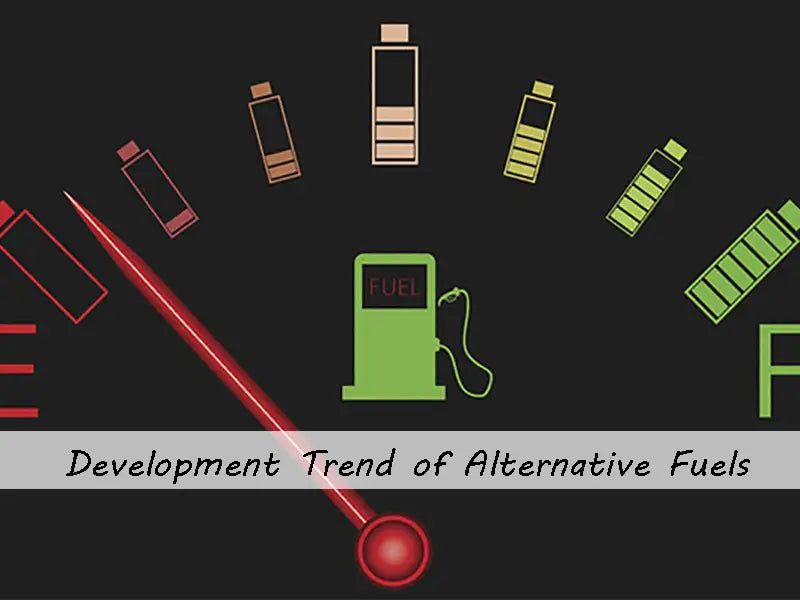
98% of the fuel and energy consumption in the global transportation industry comes from petroleum and its derivatives, and the high oil price in the international crude oil market has forced many countries, including underdeveloped, developing and developed countries, to seek to develop alternative energy sources for petroleum.
At present, the world's car ownership is about 800 million, and it is expected that the global car ownership will reach 1.2 billion by 2020. Statistics from the International Energy Agency show that in 2001, 57% of the world's petroleum fuel consumption was in the transportation sector, and it is expected that transportation fuel oil will account for more than 62% of the global petroleum fuel consumption by 2020. To this end, the world has reached a consensus that the transformation of transportation fuel energy is imperative. In addition, reducing exhaust pollution and purifying the environment has become the general direction of vehicle fuel development. Taking the European Union as an example, the "Automobile-Oil Development Plan" formulated by the 15 EU countries requires that from 1995 to 2020, seven major pollutants [CO, NOx, volatile organic substances, benzene, diesel particulate matter (PM) emitted by road transportation be discharged. ), CO2, SO2] to be greatly reduced, except for CO2, other pollutants should be reduced from an average relative value of 100 in 1995 to an average relative value of 25 in 2010, and an average relative value of 10 in 2020.
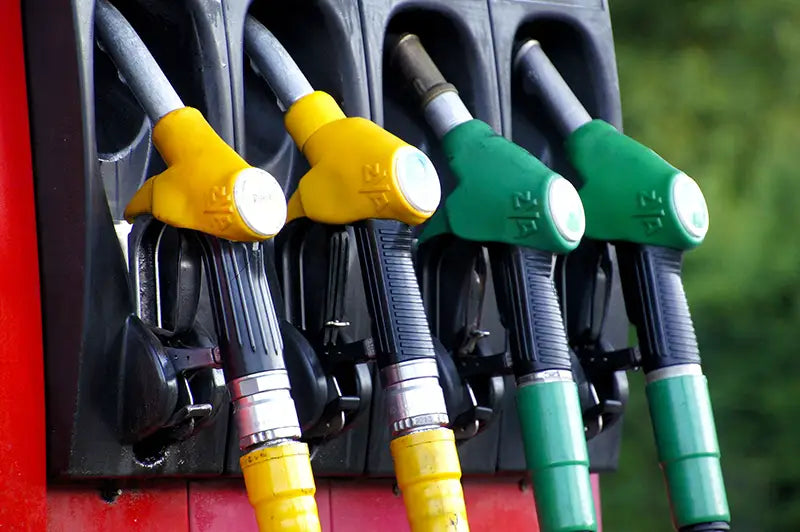
The number of automobiles in my country has exceeded 30 million, mainly in economically developed areas or central cities. Automobile exhaust emissions have become the main source of urban air pollution. At the same time, my country's oil resources are seriously insufficient. In the next 30 years, my country's automobiles will still be will increase substantially, and the problems of air pollution and energy shortage will become more serious.
In addition to stricter quality standards for gasoline and diesel fuel, it is imperative to develop cleaner alternative fuel. The figure below lists the changes in EU gasoline and diesel fuel specifications and vehicle emissions in 2005. By 2011, all gasoline and diesel fuel are required to contain less than 10μg/g of sulfur.

At present, petroleum fuel substitute products mainly include four categories: gas fuel, synthetic fuel, alkyd fuel, and biomass products.
At the 17th World Petroleum Congress, the European Union proposed a comparison of the greenhouse gas CO2 emitted by conventional gasoline, diesel fuel and alternative fuel, as shown in the figure below. Methanol and dimethyl ether are clean fuel under development. The relative molecular mass of methanol is 32 and the oxygen content is 50%. The required air-fuel ratio is only 6.4. The calorific value of the air-fuel mixture is very similar to that of gasoline. near. The relative molecular mass of dimethyl ether is 46, the oxygen content is 35%, and the air-fuel ratio is 9. The calorific value of its air-fuel mixture is higher than that of diesel fuel. The octane number of methanol is as high as about 110, and the anti-knock property is good, and the cetane number of dimethyl ether is 60, which can improve its power performance, reduce emissions and energy consumption. The properties and combustion performance of methanol fuel and dimethyl ether fuel also determine that they are cleaner than gasoline and diesel fuel, and their emission indicators are better than gasoline and diesel fuel.
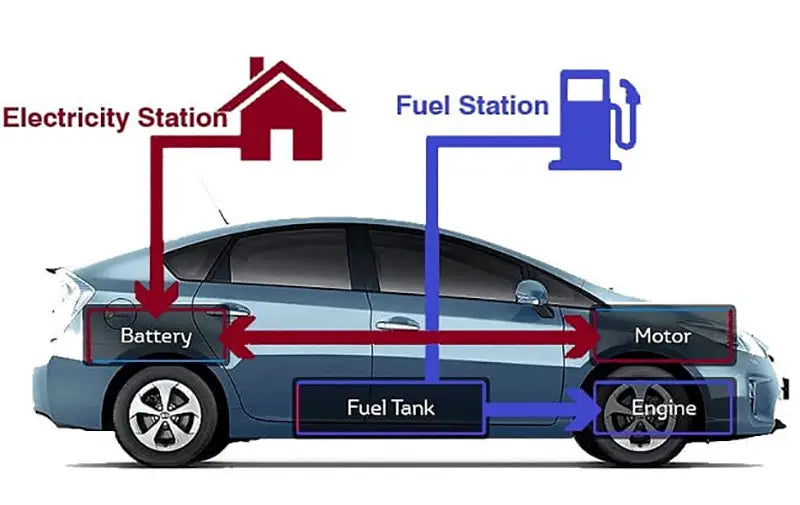
A comparison of conventional and unconventional emissions for various vehicle fuel is shown in the table below. In the case of no purifier, the conventional emissions of dimethyl ether fuel can basically reach the Euro III standard, and the methanol fuel can basically reach the Euro I standard. However, a small amount of residual sulfide in gasoline has a toxic effect on the catalytic converter of exhaust gas, which shortens the life of the catalyst. Tests on unconventional emissions of various automotive fuel by the International Energy Agency and the Methanol Fuel Research Institute of the United States show that the unconventional emissions of dimethyl ether fuel are very small, close to hydrogen; there is no benzene with high carcinogenicity in the emissions of methanol fuel. Low carcinogenicity. In the unconventional emissions of methanol fuel, there will be a trace amount of unburned methanol, which is not found in other fuel, but its content will not cause pollution hazards. The emission of formaldehyde is lower than that of diesel and higher than gasoline. Since the NOx content in the exhaust gas of methanol fuel is already very low, the purifier can temporarily not use the three-way catalyst, and the amount of platinum can be greatly reduced. It can be seen that the use of methanol fuel can greatly improve the exhaust emissions of automobiles. Even if the gasoline is mixed with methanol, it can play a role in improving the emission index to a certain extent, similar to the ethanol fuel gasoline that has been implemented. The role of dimethyl ether fuel in replacing diesel fuel in terms of clean fuel is even more obvious. Even without the catalytic purification unit, it can also reach the Euro III standard.
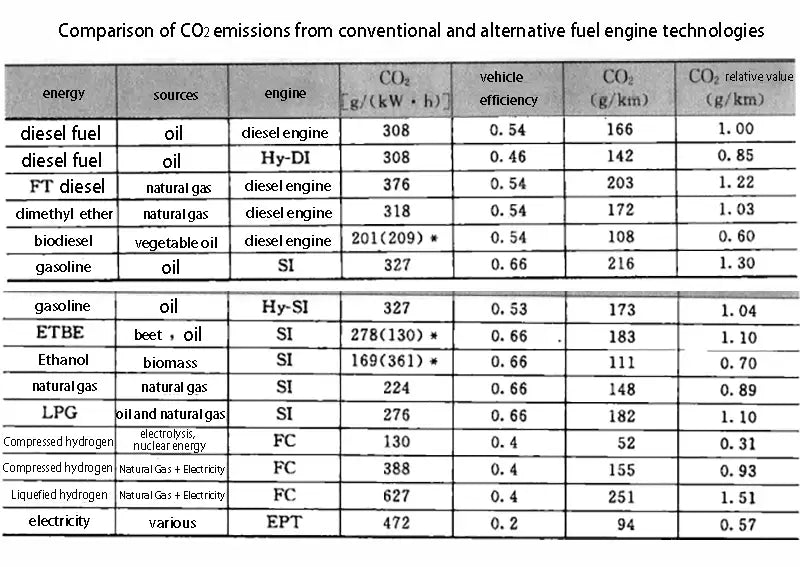
Note: FT diesel is Fischer-Tropsch synthetic diesel, ETBE is ethyl tert-butyl aldehyde, SI is ignition engine, FC is fuel cell, Hy-DI is diesel-electric hybrid vehicle, Hy-SI is gasoline-electric hybrid vehicle , EPT is an electric train. A hybrid vehicle uses a hybrid device, which consists of an electric motor and a gasoline engine. When the car starts, accelerates or climbs a hill, the gasoline engine and the electric motor work at the same time; when the car is at low speed, coasting or resting speed When the battery pack drives the electric motor, the engine charges the battery pack. This kind of car can save 20% to 40% of gasoline. At present, my country's mastery of this technology is still in the research and development stage.
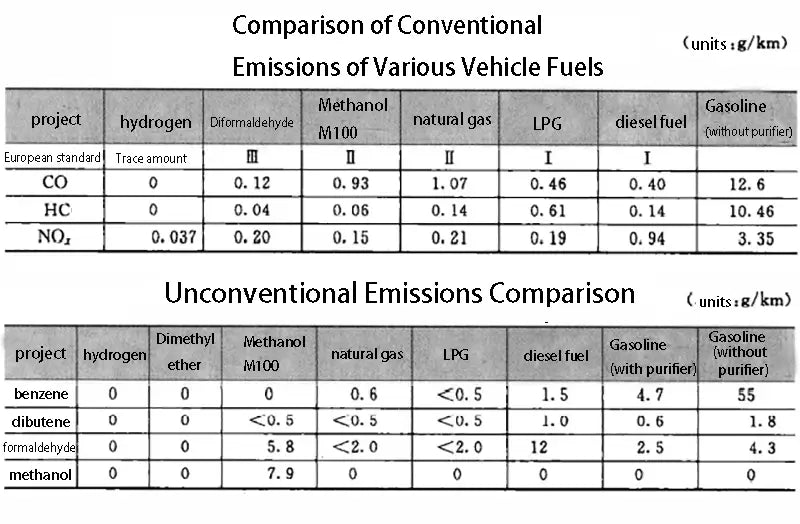
An estimated comparison of the relative prices of alternative energy fuel versus conventional energy fuel is shown in the chart below. In the 15 EU countries, the tax on gasoline and diesel is more than 70% of the final price. The average tax per liter is more than 0.7 euros for gasoline and 0.4 euros for diesel. The cost of alternative energy is still much higher than that of conventional gasoline and diesel, and the distribution fee for gasoline and diesel is 0.08 euros, while the compressed hydrogen of 30MPa is 0.72 euros. However, some alternative fuel, such as liquefied petroleum gas, compressed natural gas, and biodiesel fuel, have entered the market and enjoy preferential tax reduction conditions, thus bringing charm to their promotion and application. It can be seen that diesel, liquefied natural gas, ethanol and biodiesel have lower CO2 emissions and better economy.
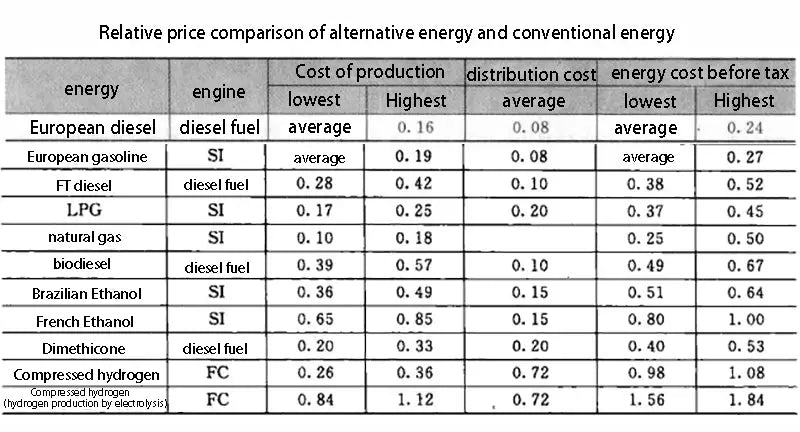
According to statistics, in the global road transportation energy consumption in 2005, conventional gasoline and diesel fuel energy was 1.67 billion t/a, of which gasoline was 990 million t/a, accounting for 60%; diesel was 680 million t/a, accounting for 40% . Alternative energy is 28.5 million t/a, accounting for about 2.5% of the total transportation fuel. According to the EU plan, by 2020, the penetration rate of alternative fuel in the EU will reach 23%, as shown in the table below. Although the cost of biofuels is now 2-3 times that of conventional fuel, and hydrogen is higher, but from the perspective of development prospects, the production cost of alternative fuel will be reduced due to technological progress, and the application will be expanded due to strict environmental protection requirements. This is the general trend of the world's vehicle fuel development. The EU will consider biofuels, natural gas and hydrogen fuel cells as preferred alternative fuel.
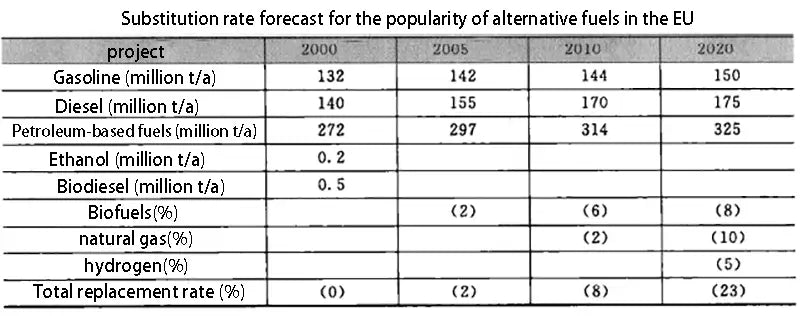
According to R.L. Polk, 1.5 million alternative fuel vehicles were sold in the United States in 2006, 50% higher than manufacturers had expected, bringing total alternative fuel vehicle sales to 10.5 million. Automakers now produce 60 alternative fuel models, including hybrids, ethanol vehicles and clean diesel vehicles, up from just 12 alternative fuel models in 2000. Currently, there are more than 10.5 million alternative fuel vehicles on the roads in every US state.
To solve long-term fuel supply problems, the development and utilization of biofuels is a practical solution. Pure and blended biofuel products have begun to enter the market in large numbers. Biofuels include bioethanol, biodiesel, ET-BE, biomethanol, and biodimethyl ether.
It is estimated that by 2015, Asia will use 1.29 million t/a of renewable fuel. India was one of the first countries to use renewable fuel, blending ethanol in nine states in 2003 and has since expanded to other regions. The target for renewable fuel in Australia is to reach about 260,000 t/a in 2010. China, Japan and other countries are also implementing, among others.
By 2015, the use of alternative fuel for vehicles is expected to increase by 2.5 times compared with the current consumption, reaching about 45 million 1/a. But even with rapid growth, renewable fuel still account for only 2.4% of total fuel, and other alternative fuel will grow, and even with larger growth, their share of total transportation fuel will not be 10 years from now Too big, but accelerating development is the trend.

Due to the different production raw material routes of various petroleum alternative fuel, there will be great differences in energy efficiency, environment and economy in the whole life cycle. For example, the energy utilization efficiency of coal is much lower than that of oil, and CO2 emissions will be significantly increased in the whole life cycle; biological fermentation requires a large amount of steam, electricity and water, and a large amount of fossil fuel are also consumed in the production process. Therefore, it is necessary to carry out the 3E evaluation of the whole life cycle of various petroleum substitute products, that is, the whole life cycle economic analysis, the whole life cycle energy analysis and the whole life cycle environmental analysis, in order to give a fair and objective evaluation of the petroleum substitute products.